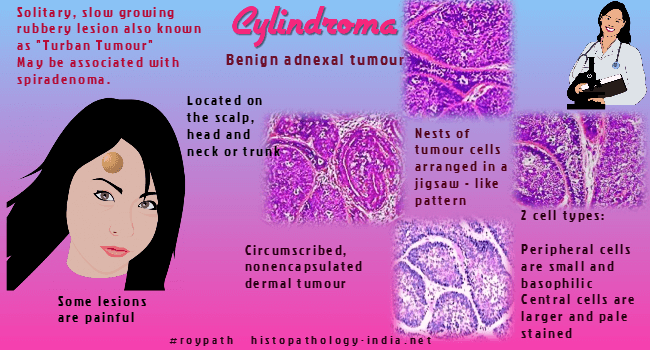|

Custom Search
|
|
Dermpath-India Pathology of Cylindroma
|

| Cylindroma is a benign
adnexal
tumour. The tumour showed apocrine and trichoepitheliomatous differentiation which indicated complex hair follicle (folliculo-sebaceous-apocrine). According to recent studies immunohistochemical examination has shown myoepithelial, apocrine, eccrine, ductal, and secretory features in both cylindromas and spiradenomas. Brooke-Spiegler syndrome represents an autosomal dominant disease characterized by the occurrence of multiple cylindromas, trichoepitheliomas and (sporadically) spiroadenomas. Clinical presentation: Clinically, the tumour usually presents as a solitary, slow growing rubbery lesion. This form is also known as 'turban tumour' and may be associated with spiradenoma. Some of these lesions are painful. Site: Usually located on the scalp, head and neck or trunk. Note: Familial cylindromatosis is a genetic disorder inherited in an autosomal manner. In this disorder numerous benign adnexal tumours develop in the head and neck region. It is caused by mutation of the CYLD gene on chromosome 16q12–13.
Differential Diagnosis: Spiradenoma- Lack of lymphoid tissue in cylindroma and presence of variable number of dendritic Langerhans cells in the tumour. These cells are CD1a positive. Malignant Cylindroma: Cylindromas occasionally undergo malignant transformation. Malignant cylindromas are characterised by islands of cells displaying marked nuclear pleomorphism. There is increase in mitosis and many abnormal forms are identified. The tumour shows invasion into the surrounding tissue and loss of the delicate hyaline sheath.
Educational Gif - Pathology of Cylindroma Brooke-Spiegler Syndrome-[Pathology Infographic]
|
|
|



